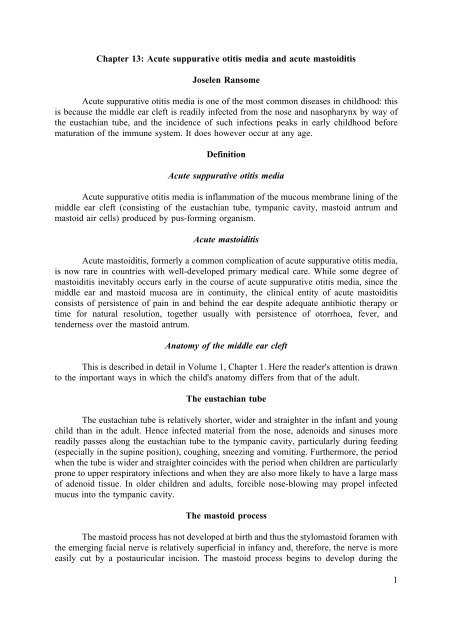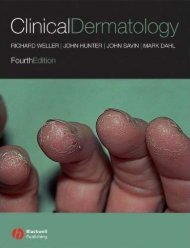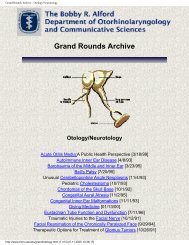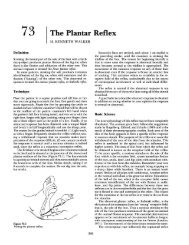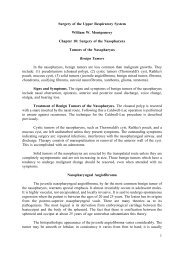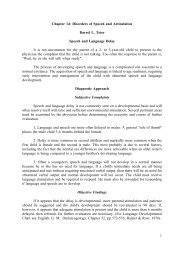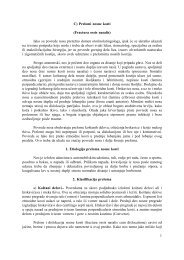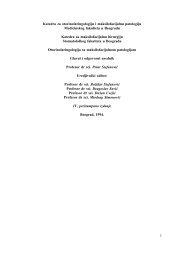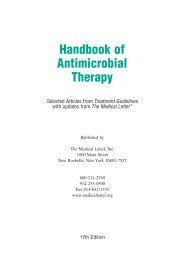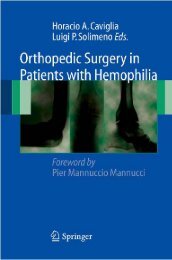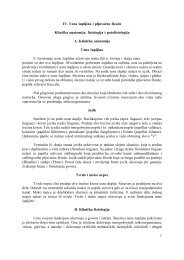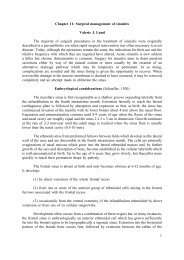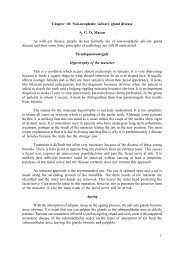1 Chapter 13: Acute suppurative otitis media and acute mastoiditis ...
1 Chapter 13: Acute suppurative otitis media and acute mastoiditis ...
1 Chapter 13: Acute suppurative otitis media and acute mastoiditis ...
Create successful ePaper yourself
Turn your PDF publications into a flip-book with our unique Google optimized e-Paper software.
<strong>Chapter</strong> <strong>13</strong>: <strong>Acute</strong> <strong>suppurative</strong> <strong>otitis</strong> <strong>media</strong> <strong>and</strong> <strong>acute</strong> <strong>mastoiditis</strong><br />
Joselen Ransome<br />
<strong>Acute</strong> <strong>suppurative</strong> <strong>otitis</strong> <strong>media</strong> is one of the most common diseases in childhood: this<br />
is because the middle ear cleft is readily infected from the nose <strong>and</strong> nasopharynx by way of<br />
the eustachian tube, <strong>and</strong> the incidence of such infections peaks in early childhood before<br />
maturation of the immune system. It does however occur at any age.<br />
Definition<br />
<strong>Acute</strong> <strong>suppurative</strong> <strong>otitis</strong> <strong>media</strong><br />
<strong>Acute</strong> <strong>suppurative</strong> <strong>otitis</strong> <strong>media</strong> is inflammation of the mucous membrane lining of the<br />
middle ear cleft (consisting of the eustachian tube, tympanic cavity, mastoid antrum <strong>and</strong><br />
mastoid air cells) produced by pus-forming organism.<br />
<strong>Acute</strong> <strong>mastoiditis</strong><br />
<strong>Acute</strong> <strong>mastoiditis</strong>, formerly a common complication of <strong>acute</strong> <strong>suppurative</strong> <strong>otitis</strong> <strong>media</strong>,<br />
is now rare in countries with well-developed primary medical care. While some degree of<br />
<strong>mastoiditis</strong> inevitably occurs early in the course of <strong>acute</strong> <strong>suppurative</strong> <strong>otitis</strong> <strong>media</strong>, since the<br />
middle ear <strong>and</strong> mastoid mucosa are in continuity, the clinical entity of <strong>acute</strong> <strong>mastoiditis</strong><br />
consists of persistence of pain in <strong>and</strong> behind the ear despite adequate antibiotic therapy or<br />
time for natural resolution, together usually with persistence of otorrhoea, fever, <strong>and</strong><br />
tenderness over the mastoid antrum.<br />
Anatomy of the middle ear cleft<br />
This is described in detail in Volume 1, <strong>Chapter</strong> 1. Here the reader's attention is drawn<br />
to the important ways in which the child's anatomy differs from that of the adult.<br />
The eustachian tube<br />
The eustachian tube is relatively shorter, wider <strong>and</strong> straighter in the infant <strong>and</strong> young<br />
child than in the adult. Hence infected material from the nose, adenoids <strong>and</strong> sinuses more<br />
readily passes along the eustachian tube to the tympanic cavity, particularly during feeding<br />
(especially in the supine position), coughing, sneezing <strong>and</strong> vomiting. Furthermore, the period<br />
when the tube is wider <strong>and</strong> straighter coincides with the period when children are particularly<br />
prone to upper respiratory infections <strong>and</strong> when they are also more likely to have a large mass<br />
of adenoid tissue. In older children <strong>and</strong> adults, forcible nose-blowing may propel infected<br />
mucus into the tympanic cavity.<br />
The mastoid process<br />
The mastoid process has not developed at birth <strong>and</strong> thus the stylomastoid foramen with<br />
the emerging facial nerve is relatively superficial in infancy <strong>and</strong>, therefore, the nerve is more<br />
easily cut by a postauricular incision. The mastoid process begins to develop during the<br />
1
second year of life, by a downward growth of bone. When complete, at puberty, the<br />
stylomastoid foramen <strong>and</strong> facial nerve are then much more deeply placed on the inferior<br />
aspect of the skull deep to, <strong>and</strong> just anterior to, the mastoid process.<br />
The mastoid antrum<br />
The mastoid antrum is fully formed at birth but, as the mastoid process has not<br />
developed, it is very superficial, about 2 mm deep to the bony surface. It reaches the adult<br />
depth of about 15 mm at puberty. Thus, between infancy <strong>and</strong> puberty the antrum acquires an<br />
increased bony covering at the rate of approximately 1 mm per annum.<br />
The mastoid air cells<br />
Pneumatization of the mastoid bone occurs at the same time as the development of the<br />
mastoid process. Resorption of haemopoietic marrow occurs <strong>and</strong>, at the same time, mucous<br />
membrane from the antrum grows into the bony spaces so formed to line them, forming a<br />
complex system of interlinked air cells. Persistent infection of the bony framework of these<br />
air spaces constitutes the clinical entity of <strong>acute</strong> <strong>mastoiditis</strong>. In a small percentage of<br />
individuals, pneumatization does not take place, so although the mastoid antrum is always<br />
present, the mastoid bone is acellular <strong>and</strong> of 'ivory' type, <strong>and</strong> these patients do not develop<br />
<strong>acute</strong> <strong>mastoiditis</strong>. Inter<strong>media</strong>te types also occur, either as normal variants, or due to arrest of<br />
pneumatization by childhood ear infections.<br />
The tympanic membrane<br />
The tympanic membrane is fully formed at birth but is more horizontally placed,<br />
making access for myringotomy difficult. Along with the developments outlined above, it<br />
gradually assumes a more vertical plane.<br />
<strong>Acute</strong> <strong>suppurative</strong> <strong>otitis</strong> <strong>media</strong><br />
Aetiology<br />
Route of infection<br />
By way of the eustachian tube<br />
The relative incompetence of the eustachian tube in younger children is referred to<br />
above. The vast majority of infecting organisms reach the middle ear by way of the<br />
eustachian tube in both children <strong>and</strong> adults, most commonly from an ordinary head cold. Even<br />
after the eustachian tube reaches its adult, more protective, form, infection still reaches the<br />
middle ear by direct spread along the mucosa, or infected mucus can be propelled into the<br />
middle ear by forcible nose-blowing, sneezing, pressure changes as in flying, <strong>and</strong> forcing<br />
water up the nose as in jumping into swimming pools.<br />
2
By way of the tympanic membrane<br />
The route can be by way of the tympanic membrane, either due to a pre-existing<br />
perforation, when infected material may enter the middle ear during hair-washing, facewashing<br />
<strong>and</strong> swimming; due to a traumatic perforation by an unsterile object; or due to<br />
operative trauma, for example, myringotomy, tympanotomy, or through a ventilation tube.<br />
Blood-borne infection<br />
It is thought that some viral infections of the middle ear, including the <strong>acute</strong> specific<br />
fevers <strong>and</strong> influenza, may be blood-borne. While this chapter is concerned with <strong>acute</strong><br />
<strong>suppurative</strong> <strong>otitis</strong> <strong>media</strong> <strong>and</strong> hence with pyogenic infection, pyococci frequently follow <strong>and</strong><br />
invade tissues already affected by viruses.<br />
Age<br />
<strong>Acute</strong> <strong>suppurative</strong> <strong>otitis</strong> <strong>media</strong> is a common disease of childhood, with about five<br />
children in every 100 having at least one attack in their first 10 years (Lewis et al, 1967). The<br />
peak incidence is sometimes stated to be from 5 to 7 years, after which it declines rapidly.<br />
However, several studies have shown that the incidence is highest among preschool children,<br />
especially before the second birthday. In one such study of a population of 146822 of all ages<br />
living in various parts of Finl<strong>and</strong>, about 50% of all cases of <strong>acute</strong> <strong>suppurative</strong> <strong>otitis</strong> <strong>media</strong><br />
were found in infants under 2 years old (Puk<strong>and</strong>er et al, 1982). The annual incidence in this<br />
study was 4.4%.<br />
Sex<br />
According to Bordley, Brookhouser <strong>and</strong> Tucker (1986) 60-65% of <strong>otitis</strong> <strong>media</strong> cases<br />
in children are males. The Finnish study referred to above showed that the annual attack rater<br />
was 4.84% in males <strong>and</strong> 4.07% in females. No rationale for this apparent inequality has been<br />
identified.<br />
Socio-economic factors<br />
The incidence is highest in low hygiene populations, <strong>and</strong> under conditions of<br />
overcrowding <strong>and</strong> malnutrition.<br />
Climate<br />
A higher incidence of <strong>acute</strong> <strong>suppurative</strong> <strong>otitis</strong> <strong>media</strong> is seen in cold climates,<br />
especially in winter. The incidence is also higher in urban areas than in the country.<br />
Racial factors<br />
Studies in the USA (Brodley, Brookhouser <strong>and</strong> Tucker, 1986) have shown a higher<br />
incidence of <strong>acute</strong> <strong>suppurative</strong> <strong>otitis</strong> <strong>media</strong> in white children compared with black; a<br />
particularly high incidence is seen in Eskimos <strong>and</strong> American Indians.<br />
3
Nasopharyngeal tissue masses<br />
Adenoids<br />
Adenoids tend to block the eustachian tubes <strong>and</strong> also to act as a focus on infection<br />
from which organisms pass up the tube. However, controversy continues as to the exact role<br />
of the adenoids in <strong>acute</strong> <strong>suppurative</strong> <strong>otitis</strong> <strong>media</strong> as well as in non-<strong>suppurative</strong> middle ear<br />
effusions. Maw (1985) has shown that adenoidectomy is beneficial in resolving middle ear<br />
effusions, although the age of the child might be more significant, as children over 6 years<br />
showed better clearance than children under 6. It can be argued that the presence of adenoids,<br />
in impending eustachian tube function, would play a similar role in <strong>acute</strong> <strong>suppurative</strong> <strong>otitis</strong><br />
<strong>media</strong>. McKee, as long ago as 1963 in two careful studies showed evidence of the<br />
effectiveness of adenoidectomy in significantly reducing the incidence of <strong>acute</strong> <strong>suppurative</strong><br />
<strong>otitis</strong> <strong>media</strong>. Interestingly, he also showed that adenoidectomy alone was as effective in<br />
reducing <strong>acute</strong> <strong>suppurative</strong> <strong>otitis</strong> <strong>media</strong> as adenoidotonsillectomy, suggesting that tonsils rarely<br />
play any part in the aetiology. McKee also commented on the importance of age, the worst<br />
results having been achieved in children over 8, in whom the number of attacks would be<br />
declining anyway. However, it is well known that both children <strong>and</strong> adults with no adenoids<br />
can suffer frequent <strong>otitis</strong> <strong>media</strong> due to the many other factors involved. Careful assessment<br />
of the possible role of adenoids, as compared with other aetiological factors, in each<br />
individual case, is therefore m<strong>and</strong>atory.<br />
Other nasopharyngeal masses<br />
These act in a similar way to adenoids <strong>and</strong> include polyps, teratoma, angiofibroma,<br />
lymphoma <strong>and</strong>, in adults, carcinoma (see Volume 4, <strong>Chapter</strong> 19).<br />
Respiratory disease<br />
Chronic rhinitis <strong>and</strong> sinusitis produce a constant flow of infected mucus which may<br />
enter the eustachian tubes, while the infected sputum of bronchitis, bronchiectasis <strong>and</strong><br />
pneumonia may also be coughed into the nasopharynx <strong>and</strong> enter the tubes.<br />
Allergy<br />
The importance of allergy as an aetiological factor in <strong>acute</strong> <strong>suppurative</strong> <strong>otitis</strong> <strong>media</strong><br />
is still debatable. While allergic oedema of the eustachian tube undoubtedly occurs <strong>and</strong> might<br />
provide a rationale for recurrent <strong>acute</strong> <strong>suppurative</strong> <strong>otitis</strong> <strong>media</strong> in some cases, many atopic<br />
subjects have no ear problems.<br />
Pre-existing middle ear effusion<br />
A pre-existing middle ear effusion may act as a ready culture medium for invading<br />
pyococci.<br />
4
Immunodeficiency syndromes<br />
Immunodeficiency syndromes, including hypogammaglobulinaemias, are rare but<br />
important causes of recurrent upper respiratory infections including <strong>acute</strong> <strong>suppurative</strong> <strong>otitis</strong><br />
<strong>media</strong>, <strong>and</strong> should always be excluded when recurrences are very frequent.<br />
Chronic systemic disorders<br />
Chronic systemic disorders undoubtedly predispose to <strong>acute</strong> <strong>suppurative</strong> <strong>otitis</strong> <strong>media</strong><br />
as they do to other infective disease. Examples occurring in both children <strong>and</strong> adults are<br />
diabetes, leukaemias, anaemias, cystic fibrosis <strong>and</strong> nephritis.<br />
Cleft palate<br />
Children with cleft palate have a high incidence of middle ear disease, either <strong>acute</strong><br />
<strong>suppurative</strong> <strong>otitis</strong> <strong>media</strong> or <strong>otitis</strong> <strong>media</strong> with effusion, due to eustachian tube dysfunction<br />
secondary to the tensor palati anomaly.<br />
Primary ciliary dyskinesia<br />
Primary ciliary dyskinesia, although excessively rare <strong>and</strong> more usually associated with<br />
<strong>otitis</strong> <strong>media</strong> with effusion, can also contribute to recurrent <strong>acute</strong> <strong>suppurative</strong> <strong>otitis</strong> <strong>media</strong>.<br />
Pathology<br />
Microbiology<br />
While <strong>acute</strong> <strong>suppurative</strong> <strong>otitis</strong> <strong>media</strong> is appropriately considered as a bacterial disease,<br />
viruses undoubtedly play a role in many cases, paving the way for pyococcal invasion.<br />
Attempting to culture viruses from the middle ear in <strong>acute</strong> <strong>suppurative</strong> <strong>otitis</strong> <strong>media</strong> has a low<br />
yield of about 5% - possibly they are inactivated or absent by the time the full clinical picture<br />
has developed. At the present time, the most commonly isolated pathogens are Streptococcus<br />
pneumoniae <strong>and</strong> Haemophilus influenzae; the next most common are group A beta-haemolytic<br />
streptococcus, Staphylococcus aureus, <strong>and</strong> Neisseria catarrhalis. Gram-negative bacilli such<br />
as Pseudomonas aeruginosa, various Proteus species <strong>and</strong> Klebsiella pneumoniae have also<br />
been reported.<br />
Middle ear inflammatory process<br />
This can proceed quite rapidly, <strong>and</strong> consists of a stage of mucosal oedema with<br />
increased secretion, followed by hyperaemia, white cell infiltration <strong>and</strong> pus formation. This<br />
process clearly cannot be limited to the tympanum since the air spaces <strong>and</strong> mucosa of the<br />
entire middle ear cleft are in continuity; hence, tubal occlusion occurs due to mucosal<br />
swelling, preventing drainage, <strong>and</strong> involvement of the mastoid air cells also occur. If pus<br />
accumulates under pressure <strong>and</strong> there is tubal occlusion, the tympanic membrane may rupture.<br />
Destruction of cilia, normally present in the anterior part of the tympanum <strong>and</strong> in the tube,<br />
contributes to the poor drainage of thick secretions through the tube.<br />
5
Spread of infection<br />
Spread of infection can occur due to retrograde thrombophlebitis, bone necrosis,<br />
congenital dehiscences <strong>and</strong> fracture lines, as follows:<br />
(1) intracranially, giving rise to extradural abscess, subdural abscess, meningitis, brain<br />
abscess, lateral sinus thrombosis, <strong>and</strong> otitic hydrocephalus;<br />
(2) to the labyrinth causing <strong>suppurative</strong> labyrinthitis;<br />
(3) to the facial nerve canal, causing facial paralysis;<br />
(4) to the neck, by breaking through the mastoid tip, producing Bezold's or Citelli's<br />
abscess;<br />
(5) to the petrous apex.<br />
Details of (1) <strong>and</strong> (2) can be found in Volume 3, <strong>Chapter</strong> 12.<br />
Symptoms<br />
The variation in the clinical picture in any infection is due to the varying virulence of<br />
the invading microorganism, varying host defence, <strong>and</strong> effectiveness of <strong>and</strong> compliance in<br />
treatment.<br />
<strong>Acute</strong> <strong>suppurative</strong> <strong>otitis</strong> <strong>media</strong> can vary from a relatively minor attack of earache with<br />
tympanic membrane hyperaemia lasting a few hours, to a fulminating febrile illness perhaps<br />
with complications requiring surgery.<br />
By far the most common presenting symptom of <strong>acute</strong> <strong>suppurative</strong> <strong>otitis</strong> <strong>media</strong> is pain<br />
in the affected ear or ears which is accurately described <strong>and</strong> well located by older children<br />
<strong>and</strong> adults, who point to the ear canal <strong>and</strong> say the pain is 'deep inside', <strong>and</strong> frequently severe<br />
<strong>and</strong> throbbing. Children too young to describe their pain tend to pull at the ear lobe, or<br />
repeatedly push the ear into their pillow. The child may already be irritable, restless, off his<br />
food <strong>and</strong> seem feverish, or these symptoms may develop some hours after the onset of pain.<br />
Usually the attack will have been preceded by an upper respiratory infection, <strong>and</strong> symptoms<br />
<strong>and</strong> signs of this may be present. Deafness in the affected ear or ears will soon be noticed by<br />
older children <strong>and</strong> adults; the disease is often bilateral in children <strong>and</strong> the parents of young<br />
children would notice deafness in these cases, but in unilateral cases it may not be apparent.<br />
At this stage the disease may not progress <strong>and</strong> will gradually resolve, with the pain<br />
subsiding <strong>and</strong> the hearing gradually recovering.<br />
In many cases, however, it proceeds to a stage of intense pain, followed by rupture<br />
of the tympanic membrane <strong>and</strong> a complaint of aural discharge. A small percentage of both<br />
children <strong>and</strong> adults also complain of giddiness.<br />
6
There may be a history of one or more of the predisposing factors described under<br />
aetiology.<br />
Signs<br />
Before describing these it is important to consider the method of examining young<br />
children. It is of the utmost importance to gain their confidence as there may be only one<br />
chance to examine them - an abortive or clumsy attempt at otoscopy may result in a<br />
distraught <strong>and</strong> terrified child who will not submit to examination a second time. Children can<br />
be thought of as miniature adults with their own name <strong>and</strong> distinctive personality, <strong>and</strong> their<br />
own (sometimes inappropriate) views as to how the consultation should be conducted. They<br />
fear pain <strong>and</strong> the unknown, <strong>and</strong> should therefore be examined with the utmost gentleness,<br />
speaking to the child by name <strong>and</strong> reassuring him that by keeping still the examination will<br />
not be painful. The best position for examination is on the mother's lap: she holds the child's<br />
head against her chest with one h<strong>and</strong> on his forehead, <strong>and</strong> with her other h<strong>and</strong> restrains his<br />
arms. If possible the child's legs should be held firmly by the mother between her thighs.<br />
Ears<br />
In the early stages of <strong>acute</strong> <strong>suppurative</strong> <strong>otitis</strong> <strong>media</strong> the tympanic membrane will be<br />
injected along the h<strong>and</strong>le of the malleus, around the periphery, <strong>and</strong> sometimes over the pars<br />
flaccida. Later the whole tympanic membrane becomes hyperaemic <strong>and</strong> opaque. If infection<br />
continues <strong>and</strong> pus begins to accumulate under pressure, the pars tensa starts to bulge, mainly<br />
posteriorly, <strong>and</strong> acquires yellowish colour. Finally the tympanic membrane ruptures <strong>and</strong><br />
discharge will be seen in the external canal, which may be serous, serosanguineous,<br />
mucopurulent or frankly purulent. It is important to note whether the discharge has the shiny,<br />
glossy appearance of mucus - if the discharge contains mucus it can only come from the<br />
middle ear. The presence or absence of an offensive odour from the discharge should also be<br />
noted - if present it suggest underlying chronic <strong>otitis</strong> <strong>media</strong>. (See also Differential diagnosis<br />
below.) At this time the pain usually subsides. After mopping or aspirating discharge it is<br />
usually possible to see a small central perforation, commonly in the posterior segment of the<br />
pars tensa. Sometimes, however, the perforation may be difficult to see as the oedematous<br />
edges of the middle ear mucosa tend to obscure it. It may be located by applying a negative<br />
pressure with a Siegle's speculum, or aspirating under the operating microscope, when a blood<br />
or discharge may be seen emerging from the perforation. The perforation may also be<br />
anterior, but is only marginal or in the pars flaccida in <strong>acute</strong>-on-chronic middle ear disease.<br />
If the infection has followed trauma to the tympanic membrane a jagged perforation may be<br />
seen. If a ventilation tube is in situ, pus may be seen pulsating through the lumen.<br />
Mastoid tenderness, elicited by pressure over McEwen's triangle, may be present early<br />
in the course of <strong>acute</strong> <strong>suppurative</strong> <strong>otitis</strong> <strong>media</strong>. It assumes significance as a sign of <strong>mastoiditis</strong><br />
if it persists or increases despite adequate treatment.<br />
During resolution the hyperaemia fades <strong>and</strong> the perforation heals, often leaving no<br />
trace but sometimes leaving a scar.<br />
In older children <strong>and</strong> adults the Rinne <strong>and</strong> Weber tests will indicate conductive<br />
deafness. In younger children the hearing for a whispered voice will be impaired.<br />
7
Nose <strong>and</strong> throat<br />
As stated, the commonest cause of <strong>acute</strong> <strong>suppurative</strong> <strong>otitis</strong> <strong>media</strong> is the common cold,<br />
<strong>and</strong> examination of the nose <strong>and</strong> throat may show inflammation of the mucosa <strong>and</strong> nasal<br />
mucoid discharge. If there is bacterial rhinitis <strong>and</strong>/or sinusitis, mucopurulent or purulent nasal<br />
<strong>and</strong> postnasal discharge may be seen. Sometimes there is also <strong>acute</strong> adenoiditis with yellow<br />
patches of purulent exudate similar to tonsillitis.<br />
General signs<br />
Children are frequently febrile, but adults rarely so. A temperature of 40°C isnot<br />
unusual in children. The disease may present in neonates as a pyrexia of 'unknown' origin,<br />
occasionally even with meningitis. Other general signs would be those of any underlying<br />
general or predisposing condition.<br />
Signs of complications<br />
<strong>Acute</strong> <strong>suppurative</strong> <strong>otitis</strong> <strong>media</strong> may be a serious illness. Complications may develop<br />
rapidly <strong>and</strong> it is necessary to be alert to the signs of these.<br />
Tenderness <strong>and</strong> oedema over the mastoid process with protuberance of the pinna<br />
indicate <strong>mastoiditis</strong>, as do sagging of the posterosuperior canal wall, <strong>and</strong> granulation tissue<br />
pouting through the perforation, with discharge persisting for 3-4 weeks from the onset. (See<br />
also below, Differential diagnosis <strong>and</strong> <strong>Acute</strong> <strong>mastoiditis</strong>.)<br />
Sick children should always be tested for neck stiffness, <strong>and</strong> in severe cases a thorough<br />
examination of the central nervous system should be carried out to exclude intracranial<br />
complications. Nystagmus must be looked for in patients complaining of vertigo, <strong>and</strong> the<br />
fistula test carried out.<br />
Investigations<br />
Microbiology<br />
In all cases when otorrhea is present, an ear swab should be taken for culture <strong>and</strong><br />
sensitivity of organisms. It is not necessary routinely to culture for viruses, since these are<br />
seldom found <strong>and</strong> there is no specific treatment anyway. If the ear is not discharging it is<br />
often useful to take nose <strong>and</strong> throat swabs, since the ear will usually contain the same<br />
organisms.<br />
Blood studies<br />
A full blood count including differential white cell count is helpful in patients with<br />
<strong>acute</strong> <strong>suppurative</strong> <strong>otitis</strong> <strong>media</strong>. In very ill patients, or those in whom complications,<br />
particularly intracranial ones, are suspected, a rising leucocyte count may be the only<br />
indication that pus is accumulating somewhere as other symptoms <strong>and</strong> signs may be<br />
8
diminished by antibiotic treatment. The full blood count will also exclude or identify<br />
leukaemias, anaemias <strong>and</strong> neutropenia.<br />
Quantitative immunoglobuin electrophoresis to detect varying degrees <strong>and</strong> types of<br />
hypogammaglobulinaemia should also be carried out in patients with frequent attacks of <strong>acute</strong><br />
<strong>suppurative</strong> <strong>otitis</strong> <strong>media</strong>.<br />
Audiometry<br />
Pure tone audiometry needs to be performed fairly early in the course of <strong>acute</strong><br />
<strong>suppurative</strong> <strong>otitis</strong> <strong>media</strong>, but need not be done when the patient is in severe pain <strong>and</strong> febrile.<br />
It will obviously show conductive deafness, but its value lies in establishing a baseline <strong>and</strong><br />
monitoring the resolution of the disease.<br />
Tympanometry should not be carried out in the <strong>acute</strong> stage as it is painful <strong>and</strong> adds<br />
no useful information, but again when improvement begins it can be undertaken to establish<br />
a baseline as, not infrequently, <strong>acute</strong> <strong>suppurative</strong> <strong>otitis</strong> <strong>media</strong> leaves an unresolved middle ear<br />
effusion.<br />
Mastoid X-rays<br />
X-rays are only required if <strong>mastoiditis</strong> is diagnosed. Clouding of the mastoid air cells<br />
is always present in <strong>acute</strong> <strong>suppurative</strong> <strong>otitis</strong> <strong>media</strong>, but when there is doubt as to whether<br />
mastoid surgery is needed, X-rays are useful as evidence of breaking down of air cells<br />
(coalescent <strong>mastoiditis</strong>) will strengthen the indications (see Volume 1, chapter 17.)<br />
Urine examination<br />
Urine examination is carried out in recurrent cases to exclude diabetes.<br />
Diagnosis<br />
This is usually straightforward <strong>and</strong> is based on the history of earache, deafness, <strong>and</strong><br />
perhaps otorrhoea, probably preceded by a respiratory infection, together with the<br />
inflammatory changes found on examination which have been described above. However,<br />
there are some pitfalls <strong>and</strong> these are discussed later.<br />
Differential diagnosis<br />
This is considered later under <strong>Acute</strong> <strong>mastoiditis</strong>.<br />
Prognosis<br />
In this antibiotic era complete resolution of <strong>acute</strong> <strong>otitis</strong> <strong>media</strong> is the rule, with absence<br />
of complications, healing of the tympanic membrane, <strong>and</strong> restoration of normal hearing. In<br />
a few, a sterile middle ear effusion or a perforation persists. Only a very small percentage<br />
proceed to <strong>acute</strong> <strong>mastoiditis</strong>. The life-threatening intracranial complications are very rare, <strong>and</strong><br />
are more often associated with a pre-existing chronic <strong>otitis</strong> <strong>media</strong>.<br />
9
Complications<br />
Mastoiditis<br />
Mastoiditis may also lead to postauricular abscess or Bezold's <strong>and</strong> Citelli's abscess.<br />
Facial paralysis<br />
This subject is discussed in Volume 3, <strong>Chapter</strong> 24. Here it can be stated that facial<br />
paralysis occurring in the course of <strong>acute</strong> <strong>suppurative</strong> <strong>otitis</strong> <strong>media</strong> or <strong>acute</strong> <strong>mastoiditis</strong> almost<br />
invariably recovers completely with medical or surgical treatment of the primary condition;<br />
surgery of the nerve trunk is not required.<br />
Intracranial complications<br />
Extradural abscess, subdural abscess, meningitis, brain abscess, lateral sinus thrombosis<br />
<strong>and</strong> otitic hydrocephalus may occur.<br />
Labyrinthitis can also occur.<br />
Labyrinthitis<br />
Petrositis<br />
Petrositis <strong>and</strong> Gradenigo's syndrome are both complications.<br />
Mastoiditis <strong>and</strong> petrositis are described below. Intracranial complications <strong>and</strong><br />
labyrinthitis are rare nowadays but when they do occur it is more commonly in association<br />
with chronic <strong>otitis</strong> <strong>media</strong>. These conditions are described in Volume 3, <strong>Chapter</strong> 12.<br />
Sequelae<br />
(1) Persistence of a sterile middle ear effusion after resolution of the <strong>acute</strong><br />
inflammatory stage, causing persistence of hearing impairment.<br />
(2) High-tone sensorineural deafness, usually mild, presumably due to the<br />
inflammatory process involving the deep surface of the round window membrane.<br />
(3) Persistent perforation of the tympanic membrane can occur, more particularly in<br />
debilitated patients who have suffered a fulminating attack of <strong>acute</strong> <strong>suppurative</strong> <strong>otitis</strong> <strong>media</strong><br />
leading to more widespread necrosis of the tympanic membrane; discharge may also persist,<br />
<strong>and</strong> the disease may evolve into chronic <strong>suppurative</strong> <strong>otitis</strong> <strong>media</strong>.<br />
(4) Extensive scarring of the tympanic membrane, middle ear adhesions <strong>and</strong> resorption<br />
of ossicles may occur in recurrent cases (adhesive <strong>otitis</strong>). Hyalinized collagen deposits in the<br />
middle ear <strong>and</strong> tympanic membrane (tympanosclerosis) may also occur.<br />
10
Treatment of <strong>acute</strong> <strong>suppurative</strong> <strong>otitis</strong> <strong>media</strong><br />
Treatment of <strong>acute</strong> <strong>suppurative</strong> <strong>otitis</strong> <strong>media</strong> is considered under the following<br />
headings:<br />
(1) curative<br />
medical<br />
general<br />
analgesics<br />
topical<br />
antibiotics<br />
[decongestants]<br />
surgical - myringotomy<br />
(2) [prophylactic]<br />
(3) treatment of associated conditions<br />
(4) treatment of complications.<br />
The square brackets indicate treatment modes not generally considered to be<br />
appropriate.<br />
Curative<br />
Medical treatment<br />
General<br />
Both children <strong>and</strong> adults are best managed in bed in the <strong>acute</strong> phase, in a warm room,<br />
of adequate humidity to maintain ciliary function. Febrile <strong>and</strong> toxic children will need no<br />
persuasion to stay in bed; afebrile children can be allowed up but kept indoors. As in any<br />
infective illness, nourishment <strong>and</strong> fluid intake must be adequate, <strong>and</strong> supplementary vitamins,<br />
especially C, can be added if the patient's normal diet is thought to be inadequate. Some<br />
patients, both children <strong>and</strong> adults, are better managed in hospital, depending on the severity,<br />
length of history, response to previous treatment, <strong>and</strong> other factors such as association with<br />
diabetes or other illness. Hospitalization provides the opportunity for frequent observation of<br />
the general <strong>and</strong> local condition, <strong>and</strong> for investigations, if complications are suspected or<br />
surgery is considered.<br />
Analgesics<br />
These must be given in adequate dosage <strong>and</strong> with sufficient frequency to control pain.<br />
Topical<br />
When otorrhoea is present the discharge should be gently mopped with dry sterile<br />
cotton wool or sucked from the canal, as often as it recurs. A piece of cotton wool can be<br />
placed at the orifice of the ear canal to prevent the discharge running down <strong>and</strong> excoriating<br />
the skin of the ear lobe.<br />
11
Antibiotics<br />
Most otologists <strong>and</strong> primary care physicians in the UK would favour early<br />
administration of antibiotics in all but the most minor cases, despite the fact that some cases<br />
may be viral, <strong>and</strong> notwithst<strong>and</strong>ing the need to avoid overprescribing. Van Buchem, Peeters<br />
<strong>and</strong> Van't Hof (1985) disagree with this <strong>and</strong> advocate withholding antibiotics for 3-4 days,<br />
asserting that the vast majority of cases recover with symptomatic treatment only. However,<br />
the widely observed <strong>and</strong> rapid decline, since the advent of antibiotics, of <strong>acute</strong> <strong>mastoiditis</strong>,<br />
formerly an extremely common complication of <strong>acute</strong> <strong>suppurative</strong> <strong>otitis</strong> <strong>media</strong>, supports the<br />
concept that antibiotics limit the disease <strong>and</strong> minimize its consequences. Minor cases in which<br />
the pain lasts for only a few hours do not require treatment, nor those in whom pain is very<br />
slight. In practice a 'trial' of no treatment is usually inevitable as it may be 12-24 hours before<br />
the patient can obtain medical care.<br />
Route of administration. Oral administration is the route of choice except in very<br />
severe cases. In these one or more antibiotics may be given intravenously.<br />
Duration. Antibiotics should usually be given for 5-10 days, depending on the severity<br />
of the case. If a patient is treated at home the importance of treatment compliance should be<br />
emphasized.<br />
Choice of antibiotic. Administration should not be begun before an ear swab is taken<br />
(or nose <strong>and</strong> throat swabs if the ear is not discharging), but after this there is no need to wait<br />
for the result. Amoxycillin is a useful first-line treatment as it is well tolerated <strong>and</strong> the<br />
common bacteria of <strong>acute</strong> <strong>suppurative</strong> <strong>otitis</strong> <strong>media</strong> are usually sensitive to it. Other useful<br />
antibiotics are erythromycin, trimethoprim, trimethoprim with sulphamethoxazole (cotrimoxazole),<br />
<strong>and</strong> cefaclor. Severe <strong>and</strong> fulminating cases can be given a combination of<br />
ampicillin, flucloxacillin <strong>and</strong> metronidazole intravenously.<br />
The response to the chosen regimen should be monitored carefully <strong>and</strong>, if ineffective,<br />
it should be altered according to the results of the swab cultures <strong>and</strong> organism sensitivities.<br />
Decongestants<br />
Both systemic <strong>and</strong> topical decongestants are often prescribed in the hope that they will<br />
improve the patency of the eustachian tube <strong>and</strong> thus improve middle ear drainage. The use<br />
of systemic decongestants has a logical basis as pseudoephedrine <strong>and</strong> phenylephrine have been<br />
shown to increase tubal patency in dogs (Jackson, 1971); unfortunately, however, many trials<br />
have now shown that systemic decongestants are no better than a placebo in the management<br />
of middle ear disease. Admittedly, some trials were more concerned with secretory <strong>otitis</strong><br />
<strong>media</strong> but Olson et al (1978) studied 169 children with <strong>acute</strong> <strong>suppurative</strong> <strong>otitis</strong> <strong>media</strong> <strong>and</strong><br />
treated all with antibiotics plus either pseudoephedrine or placebo; the outcome was the same<br />
in both groups. Possibly the doses commonly used do not produce effective vasoconstriction,<br />
or vasoconstriction may occur, only to be followed by the rebound phenomenon observed in<br />
the nose after the use of some nasal sprays. Since systemic administration of pseudoephedrine<br />
<strong>and</strong> similar compounds may sometimes cause sleep disturbance, irritability <strong>and</strong>, occasionally,<br />
12
psychotic symptoms, especially in children, the conclusion is inescapable that their use is<br />
unwise.<br />
Topical decongestants are also widely prescribed but the passage of drops or nebulized<br />
particles through the nose <strong>and</strong> nasopharynx seems hardly likely to produce a useful effect on<br />
the eustachian tube. Lilholdt et al (1982) did not find any improvement in eustachian tube<br />
function in children with proved severe tubal dysfunction after their noses were sprayed with<br />
either oxymetazoline hydrochloride or placebo. The use of topical decongestants in <strong>acute</strong><br />
<strong>suppurative</strong> <strong>otitis</strong> <strong>media</strong> is not recommended as they are unlikely to produce a useful effect<br />
on the eustachian tube.<br />
Surgical treatment<br />
While the vast majority of ears with <strong>acute</strong> <strong>suppurative</strong> <strong>otitis</strong> <strong>media</strong> will respond to the<br />
above regimen of appropriate antibiotics, bed-rest <strong>and</strong> analgesia, <strong>and</strong> while some tympanic<br />
membranes will rupture spontaneously with or without treatment, in a very small minority<br />
there is persistence of pain <strong>and</strong> temperature with a red bulging tympanic membrane despite<br />
adequate medical management. Myringotomy should then be undertaken with a view to<br />
releasing pus accumulating under pressure.<br />
The operation is carried out under general anaesthesia using an operating microscope,<br />
<strong>and</strong> with full aseptic procedures. The patient is placed supine on the operating table with the<br />
head turned to one side. Using an aural speculum <strong>and</strong> angled myringotome, a radial incision<br />
is made in the posteroinferior segment; the maximum bulging is posterior in <strong>acute</strong> <strong>suppurative</strong><br />
<strong>otitis</strong> <strong>media</strong>, <strong>and</strong> the inferior incision avoids the risk of damaging the ossicular chain, chorda<br />
tympani <strong>and</strong> facial nerve. Pus then gushes out under pressure, <strong>and</strong> a swab is taken <strong>and</strong> sent<br />
for culture <strong>and</strong> sensitivities. Residual pus is gently sucked out. The incision should be about<br />
3-4 mm in length; tiny incisions tend to heal too quickly <strong>and</strong> allow put to reaccumulate in the<br />
middle ear cleft. Ventilation tubes should not be inserted in <strong>acute</strong> <strong>suppurative</strong> <strong>otitis</strong> <strong>media</strong>.<br />
Postoperatively, on recovering from anaesthesia the patient will usually say that the<br />
earache has disappeared, <strong>and</strong> generally the temperature quickly returns to normal. Antibiotic<br />
treatment is continued until resolution is virtually complete, but the regimen is changed if<br />
necessary as soon as the results of the swab taken at operation are known.<br />
Prophylactic treatment<br />
Long-term daily treatment with antibiotics or sulphamethoxazole has been shown to<br />
be effective in reducing the number of episodes in patients prone to <strong>acute</strong> <strong>suppurative</strong> <strong>otitis</strong><br />
<strong>media</strong>. However, all antibiotics are potentially toxic <strong>and</strong> long-term prophylaxis with oral<br />
antibiotics is not generally recommended as the risks may be greater than the risk of another<br />
attack of <strong>acute</strong> <strong>suppurative</strong> <strong>otitis</strong> <strong>media</strong>. (Note that this statement applies only to recurrent<br />
<strong>acute</strong> <strong>suppurative</strong> <strong>otitis</strong> <strong>media</strong> <strong>and</strong> it is recognized that there may be a place for such<br />
prophylaxis in other conditions.) Occasionally <strong>acute</strong> <strong>suppurative</strong> <strong>otitis</strong> <strong>media</strong> occurs so<br />
frequently <strong>and</strong> with such severity that a trial of continuous antibiotic treatment, especially in<br />
the winter, is justified.<br />
<strong>13</strong>
Treatment of associated conditions<br />
The treatment of <strong>acute</strong> <strong>suppurative</strong> <strong>otitis</strong> <strong>media</strong>, especially when recurrent, should<br />
include a search for <strong>and</strong> management of treatable associated disease. The role of the adenoids<br />
has been considered under Aetiology above, <strong>and</strong> many otologists would consider it necessary<br />
to remove the adenoids in some cases of recurrent <strong>acute</strong> <strong>suppurative</strong> <strong>otitis</strong> <strong>media</strong>.<br />
Adenoidectomy should be carefully <strong>and</strong> thoroughly performed with special attention to<br />
removal of adenoid tissue from the fossae of Rosenmüller. Rhinitis <strong>and</strong> sinusitis should also<br />
be looked for <strong>and</strong> treated vigorously. The presence of lower respiratory infection requires<br />
treatment with the help of a paediatrician or respiratory physician. Other conditions referred<br />
to under Aetiology must receive the appropriate management, for example early repair of cleft<br />
palate.<br />
Treatment of complications <strong>and</strong> sequelae<br />
Persistence of middle ear effusion<br />
This is a common sequel to an attack of <strong>acute</strong> <strong>suppurative</strong> <strong>otitis</strong> <strong>media</strong> <strong>and</strong> therefore<br />
there must be careful follow-up of each case, with otoscopy supplemented by tympanometry<br />
<strong>and</strong> pure tone audiometry as necessary, until complete resolution occurs or persistence of fluid<br />
is found. The management is described in <strong>Chapter</strong> 12.<br />
Persistent perforation of the tympanic membrane<br />
See Volume 3, <strong>Chapter</strong> 10.<br />
Labyrinthitis <strong>and</strong> intracranial complications<br />
These are described in Volume 3, <strong>Chapter</strong> 12.<br />
Facial paralysis<br />
Facial paralysis occurring in the course of middle ear cleft infection is usually due to<br />
a dehiscent facial nerve canal - when the infection is controlled in most cases the facial nerve<br />
recovers.<br />
Mastoiditis <strong>and</strong> petrositis<br />
Mastoiditis <strong>and</strong> petrositis are described below.<br />
<strong>Acute</strong> <strong>mastoiditis</strong><br />
Aetiology <strong>and</strong> pathology<br />
In developed countries with effective primary <strong>and</strong> secondary health care, <strong>acute</strong><br />
<strong>mastoiditis</strong> is nowadays rare, largely due to the widespread use of antibiotics for <strong>acute</strong><br />
<strong>suppurative</strong> <strong>otitis</strong> <strong>media</strong>. However, if the preceding attack is untreated, or fails to respond, the<br />
inflammatory process will persist <strong>and</strong> increase in the mastoid air cells. The accumulation of<br />
14
pus in the air cells leads to necrosis of the bony walls of the cells producing the so-called<br />
'coalescent <strong>mastoiditis</strong>'. For a time the disease may remain walled off within the mastoid<br />
bone, but eventually it will spread:<br />
(1) laterally through the lateral outer table of the mastoid bone to give a subperiosteal<br />
abscess <strong>and</strong>, if pus ruptures through the periosteum, a subcutaneous abscess.<br />
(2) superiorly <strong>and</strong> posteriorly, giving rise to:<br />
(i) extradural abscess<br />
(ii) subdural abscess<br />
(iii) meningitis<br />
(iv) brain abscess of (a) the temporal lobe or (b) the cerebellum<br />
(v) lateral sinus thrombosis<br />
(vi) otitic hydrocephalus<br />
(3) <strong>media</strong>lly causing labyrinthitis or petrositis <strong>and</strong> Gradenigo's syndrome<br />
(4) inferiorly through the mastoid process tip or <strong>media</strong>l wall causing Bezold's abscess,<br />
caused by pus tracking along the sternomastoid muscle or Citelli's abscess caused by pus<br />
tracking along the posterior belly of the digastric muscle<br />
(5) anteriorly to the facial nerve canal causing facial paralysis, <strong>and</strong> also to the posterosuperior<br />
external auditory canal wall, causing the appearance of sagging of the meatal skin<br />
in that area.<br />
Predisposing factors<br />
These are the same as described above for <strong>acute</strong> <strong>suppurative</strong> <strong>otitis</strong> <strong>media</strong>. The disease<br />
can occur at any age, but is far more common in children.<br />
History<br />
The patient will have had an attack of <strong>acute</strong> <strong>suppurative</strong> <strong>otitis</strong> <strong>media</strong>, with the<br />
characteristic symptoms <strong>and</strong> signs described above, anything from a few days up to 3 or 4<br />
weeks previously. The attack of <strong>acute</strong> <strong>suppurative</strong> <strong>otitis</strong> <strong>media</strong> will probably have been<br />
preceded by a head cold or other upper respiratory infection or, in children, by an <strong>acute</strong><br />
specific fever, such as measles or scarlet fever.<br />
Symptoms<br />
General<br />
Mastoiditis is frequently a serious illness with pyrexia <strong>and</strong> general malaise. Fever,<br />
restlessness <strong>and</strong> refusal of food may be the only symptoms in very young children.<br />
15
Local<br />
Commonly there is persistence of earache, otorrhoea <strong>and</strong> increasing hearing<br />
impairment, from the time of onset of the preceding <strong>acute</strong> <strong>suppurative</strong> <strong>otitis</strong> <strong>media</strong>.<br />
Sometimes the original symptoms abate, especially if antibiotic treatment has been given, only<br />
to recur, together with fever, some 2-4 weeks later. Occasionally the only symptom is<br />
persistent profuse otorrhoea. The patient may complain of nasal obstruction or nasal<br />
discharge. The presence of unilateral headache is a danger sign suggesting the onset of<br />
intracranial complications. Similarly a complaint of giddiness is a warning that labyrinthitis<br />
is imminent, or developing.<br />
Signs<br />
General<br />
The patient will frequently appear pale, ill <strong>and</strong> restless. There may be pyrexia of 40°C<br />
or more in children, though in adults pyrexia may be low or absent.<br />
Local<br />
External auditory canal<br />
On examination of the external auditory canal, there may be discharge, either<br />
mucopurulent or purulent, but seldom offensive, unless <strong>acute</strong> disease has occurred on<br />
previously chronic <strong>otitis</strong> <strong>media</strong>; the discharge may be seen to pulsate through a perforation.<br />
Sagging of the postero-superior canal wall may be present.<br />
Tympanic membrane<br />
Perforation of the tympanic membrane is almost invariably present, <strong>and</strong> is nearly<br />
always postero-central - occasionally, however, <strong>mastoiditis</strong> can develop behind an intact<br />
tympanic membrane, which will appear red <strong>and</strong> full or bulging.<br />
Granulations or a polyp, bright red in colour, may be seen pouting through the<br />
perforation when disease has been present for weeks rather than days.<br />
Signs of complications such as severe headache, drowsiness, vomiting, <strong>and</strong> neck<br />
stiffness are serious indications of intracranial complications <strong>and</strong> must prompt an im<strong>media</strong>te<br />
<strong>and</strong> thorough examination of the central nervous system. Vertigo with nystagmus suggests<br />
labyrinthitis.<br />
Postauricular area<br />
Mastoid tenderness elicited by pressure over McEwen's triangle, will invariably be<br />
present. It will probably have persisted from the onset of the preceding <strong>acute</strong> <strong>suppurative</strong><br />
<strong>otitis</strong> <strong>media</strong> attack, <strong>and</strong> may increase.<br />
16
Swelling over the mastoid bone may be present, <strong>and</strong> if so either the postauricular<br />
groove is accentuated indicating that the pus is still subperiosteal, or the postauricular groove<br />
is absent, because either the periosteum has given way <strong>and</strong> the pus is subcutaneous, or there<br />
is simple inflammatory oedema over the mastoid.<br />
The presence of fluctuation will distinguish the later abscess formation from the earlier<br />
simple inflammatory oedema.<br />
Protuberance of the pinna can occur either due to simple inflammatory oedema over<br />
the mastoid, or to subcutaneous abscess; subperiosteal abscess with retention of the<br />
postauricular groove does not push the pinna forwards unless the abscess is very large.<br />
Investigations<br />
These are the same as for <strong>acute</strong> <strong>suppurative</strong> <strong>otitis</strong> <strong>media</strong> but the points below should<br />
be remembered.<br />
Microbiology<br />
It is particularly important to obtain an ear swab <strong>and</strong> an early report on the culture <strong>and</strong><br />
sensitivities in case the organisms are not sensitive to the first treatment. Patients, particularly<br />
children, may have a serious illness which in turn may lead to further complications such as<br />
meningitis, <strong>and</strong> valuable time will be lost in treating this potentially lethal condition if culture<br />
is not performed. In more severe cases initial blood cultures are also indicated.<br />
Blood studies<br />
A full blood count should be carried out promptly, <strong>and</strong> repeated during the course of<br />
the disease. A rising leucocyte count invariably indicates pus accumulating <strong>and</strong> unless there<br />
is an obvious cause such as a fluctuant postauricular abscess, signs of intracranial spread must<br />
be looked for.<br />
Audiometry<br />
A pure tone audiogram may show as much as 40-50 dB of conductive hearing loss;<br />
comparison with an audiogram performed during the preceding <strong>acute</strong> <strong>suppurative</strong> <strong>otitis</strong> <strong>media</strong><br />
attack may show that the hearing loss has increased. If the patient is ill, or the mastoid is very<br />
tender, only Rinne <strong>and</strong> Weber tests are called for.<br />
Mastoid X-rays<br />
While seldom required in simple <strong>acute</strong> <strong>suppurative</strong> <strong>otitis</strong> <strong>media</strong>, X-rays will show not<br />
only clouding of cells, which is always present in <strong>acute</strong> <strong>suppurative</strong> <strong>otitis</strong> <strong>media</strong> but also<br />
breaking down of bony air cell walls, indicating progressive disease, or coalescent <strong>mastoiditis</strong>.<br />
The films are also a useful guide, if surgery is required, as to the extent of pneumatization,<br />
which varies greatly (see <strong>Chapter</strong> 2).<br />
17
Diagnosis<br />
Diagnosis is made on the history, symptoms <strong>and</strong> signs, supported by X-rays, as already<br />
described. The principal features can be summarized as follows: an attack of <strong>acute</strong> <strong>suppurative</strong><br />
<strong>otitis</strong> <strong>media</strong> fails to resolve <strong>and</strong> is followed by persistent or recurrent earache, pyrexia <strong>and</strong><br />
otorrhoea, increasing deafness, together with mastoid tenderness <strong>and</strong> sometimes a protuberant<br />
pinna.<br />
Differential diagnosis of <strong>acute</strong> <strong>suppurative</strong> <strong>otitis</strong> <strong>media</strong> <strong>and</strong><br />
<strong>acute</strong> <strong>mastoiditis</strong> from other conditions<br />
<strong>Acute</strong> <strong>suppurative</strong> <strong>otitis</strong> <strong>media</strong><br />
<strong>Acute</strong> <strong>suppurative</strong> <strong>otitis</strong> <strong>media</strong> may sometimes have to be distinguished from the<br />
following conditions.<br />
Otitis externa<br />
Otitis externa may also give earache <strong>and</strong> otorrhoea, <strong>and</strong> the tympanic membrane may<br />
appear red as the outer layer is in continuity with the canal epithelium <strong>and</strong> is frequently<br />
involved in the inflammatory process. The discharge is frequently watery, but if purulent it<br />
never has the shiny, glossy appearance of middle ear discharge due to the presence of mucus.<br />
The hearing in <strong>otitis</strong> externa is normal or only slightly impaired (except when the canal is<br />
blocked by discharge), whereas in <strong>acute</strong> <strong>suppurative</strong> <strong>otitis</strong> <strong>media</strong> the hearing loss is usually<br />
more marked. Itching is a very common feature of <strong>otitis</strong> externa, but does not occur in <strong>acute</strong><br />
<strong>suppurative</strong> <strong>otitis</strong> <strong>media</strong>. Very severe <strong>otitis</strong> externa may mimic <strong>acute</strong> <strong>mastoiditis</strong> (see below).<br />
Tympanic membrane hyperaemia<br />
The whole tympanic membrane can become quite diffusely red in a child who is<br />
crying. Since he may be crying because he has earache, time must be allowed for him to<br />
settle down <strong>and</strong> then the examination is repeated. The insertion of an aural speculum may<br />
cause slight flushing down the h<strong>and</strong>le of the malleus <strong>and</strong> round the periphery of the pars<br />
tensa, so examination should be very gentle to avoid confusion with this early sign of<br />
developing <strong>acute</strong> <strong>suppurative</strong> <strong>otitis</strong> <strong>media</strong>.<br />
Otitis <strong>media</strong> with effusion<br />
The tympanic membrane may sometimes look pinkish <strong>and</strong> opaque, but is never as<br />
intensely red as in <strong>acute</strong> <strong>suppurative</strong> <strong>otitis</strong> <strong>media</strong>.<br />
Myringitis haemorrhagica bullosa<br />
This condition frequently occurs during epidemics or respiratory viruses such as<br />
influenza, <strong>and</strong> is characterized by excruciating earache followed by a small quantity of<br />
serosanguineous discharge. Inspection of the tympanic membrane shows either the presence<br />
of haemorrhagic blebs, or the outlines of ruptured blebs. When uncomplicated the hearing is<br />
18
usually normal. Secondary bacterial invasion of the middle ear may occur, so the two<br />
conditions may coexist.<br />
Other causes of otalgia<br />
There are many causes of otalgia remote from the ear itself, <strong>and</strong> these are discussed<br />
in Volume 3, <strong>Chapter</strong> <strong>13</strong>. The diagnostic point here is that the patient with pain referred to<br />
the ear from some other structure will have a perfectly normal tympanic membrane <strong>and</strong><br />
hearing.<br />
<strong>Acute</strong> <strong>mastoiditis</strong><br />
This may have to be distinguished from the following conditions.<br />
<strong>Acute</strong> severe <strong>otitis</strong> externa<br />
<strong>Acute</strong> severe <strong>otitis</strong> externa is usually localized in the form of a furuncle. This may<br />
lead to really marked postauricular oedema <strong>and</strong> protuberance of the pinna <strong>and</strong> this, together<br />
with severe earache <strong>and</strong> some purulent otorrhoea, produces the resemblance to <strong>acute</strong><br />
<strong>mastoiditis</strong>. However, in furunculosis there is severe pain on pushing the tragus gently in <strong>and</strong><br />
on pulling gently on the pinna; this does not occur in <strong>acute</strong> <strong>mastoiditis</strong>. There will be no<br />
history of a preceding attack of <strong>acute</strong> <strong>suppurative</strong> <strong>otitis</strong> <strong>media</strong>. The hearing is usually normal<br />
or only slightly impaired (unlike <strong>mastoiditis</strong>) unless the canal is completely occluded by<br />
swelling or discharge. If the postauricular groove is accentuated, this is a sign of subperiosteal<br />
pus which has spread from the mastoid. X-rays of the mastoids will show apparent cloudiness<br />
of the air cells in either condition (due in external <strong>otitis</strong> to the overlying oedema), but if<br />
breaking down of the bony mastoid air cell walls is shown, this indicates that <strong>mastoiditis</strong> is<br />
present.<br />
Postauricular lymphadenitis<br />
Very rarely, suppuration in a postauricular lymph node, due to infection in the skin<br />
or scalp, may cause confusion. However the tympanic membrane, external auditory canal <strong>and</strong><br />
hearing will be found to be normal.<br />
Erysipelas<br />
Erysipelas may occasionally affect the skin of the postauricular area, <strong>and</strong> resemble<br />
<strong>mastoiditis</strong> because of pain, fever <strong>and</strong> red oedematous skin. However, careful examination<br />
will reveal a raised, red spreading edge of the lesion, contrasting sharply with the normal pale<br />
adjacent skin. The external canal skin, tympanic membrane, <strong>and</strong> the hearing will all be<br />
normal.<br />
Complications of <strong>acute</strong> <strong>mastoiditis</strong><br />
These have been referred to under Pathology <strong>and</strong> will not be described here, except<br />
petrositis. The reader is reminded that labyrinthitis <strong>and</strong> the intracranial complications are<br />
discussed in the chapter on complications of <strong>otitis</strong> <strong>media</strong> (Volume 3, <strong>Chapter</strong> 12).<br />
19
<strong>Acute</strong> petrositis<br />
The degree of pneumatization of the temporal bone is extremely variable, but may<br />
extend right through the petrous bone to its apex. If so, when there is <strong>mastoiditis</strong>, there is<br />
nothing except host defence <strong>and</strong> timely treatment to prevent infection spreading right to the<br />
petrous apex. However, <strong>acute</strong> petrositis is now excessively rare, <strong>and</strong> even in the preantibiotic<br />
era it was not common.<br />
Clinical picture<br />
The clinical picture is that of the preceding <strong>acute</strong> <strong>suppurative</strong> <strong>otitis</strong> <strong>media</strong> <strong>and</strong> <strong>acute</strong><br />
<strong>mastoiditis</strong> which fails to respond to treatment, sometimes even if this included cortical<br />
mastoidectomy. There is persistence of earache <strong>and</strong> temperature, then pain is felt in the<br />
distribution of the ipsilateral trigeminal (fifth cranial) nerve. Finally, involvement of the<br />
ipsilateral abducent (sixth cranial) nerve gives rise to diplopia, <strong>and</strong> examination of the eye<br />
movements will show paralysis of the external rectus muscle of the eyeball on the affected<br />
side (sixth nerve paralysis).<br />
Gradenigo's syndrome<br />
The features of this are <strong>acute</strong> infection of the middle ear cleft, associated with<br />
discharge of pus from the ear, pain in the distribution of the trigeminal nerve <strong>and</strong> sixth nerve<br />
paralysis. The syndrome is due to the close anatomical relationship of the fifth <strong>and</strong> sixth<br />
nerves with the petrous apex. But, besides <strong>acute</strong> petrositis, it may also be due to an extradural<br />
abscess or a patch of meningitis overlying the petrous apex.<br />
diagnosis<br />
Diagnosis depends on the foregoing clinical picture, assisted by polytomography <strong>and</strong>/or<br />
computerized tomographic scanning of the temporal bone.<br />
Treatment<br />
Intensive antibiotic treatment is begun im<strong>media</strong>tely <strong>and</strong>, in a previously untreated case<br />
with a short history, this may well be all that is required. However if the patient fails to<br />
respond in 24-48 hours, or if cortical mastoidectomy has already been performed but the<br />
disease nevertheless progresses to petrositis, further surgical exploration will be required. This<br />
is considered below following surgical treatment of <strong>acute</strong> <strong>mastoiditis</strong>.<br />
Treatment of <strong>acute</strong> <strong>mastoiditis</strong><br />
Medical<br />
Even when a child or adult presents with an advanced case of <strong>acute</strong> <strong>mastoiditis</strong> with<br />
postauricular oedema <strong>and</strong> protuberant pinna, the treatment is initially medical in hospital, <strong>and</strong><br />
the majority of these cases will resolve completely. Exceptions are cases with postauricular<br />
fluctuation, previous adequate medical management, or suspected intracranial complications.<br />
20
The patient should be admitted to hospital so that he can be monitored carefully to<br />
ensure resolution or to detect lack of progress or early signs of complications. The treatment<br />
regimen is as described for <strong>acute</strong> <strong>suppurative</strong> <strong>otitis</strong> <strong>media</strong>, with a preference for intravenous<br />
antibiotic therapy in advanced cases.<br />
Cortical mastoidectomy is indicated:<br />
Surgical<br />
Cortical mastoidectomy<br />
(1) if subperiosteal fluctuation, suspected intracranial complications, or a neck abscess<br />
are present when the case presents<br />
(2) if there is persistence of pain, temperature, <strong>and</strong> otorrhoea, or even profuse<br />
otorrhoea on its own, after 2-4 weeks of adequate medical management including use of the<br />
correct antibiotic based on culture results, <strong>and</strong> known compliance in the antibiotic regimen.<br />
The aim of the operation is to exenterate the mastoid air-cell system as completely as<br />
possible; the ossicular chain is not disturbed.<br />
Preoperative investigation<br />
Besides those previously mentioned, the patient's fitness for general anaesthesia should<br />
be assessed, when possible an im<strong>media</strong>te preoperative audiogram should be performed, <strong>and</strong><br />
the central nervous system examined to exclude or assess intracranial complications (with<br />
particular reference to facial movements to exclude a preoperative facial paralysis or<br />
nystagmus). Mastoid X-rays not only help to confirm the indications for surgery, but also give<br />
guidance to the surgeon on the extent of pneumatization <strong>and</strong> the positions of the dura of the<br />
middle <strong>and</strong> posterior cranial fossae.<br />
Preparation<br />
A postauricular incision is used <strong>and</strong> as it is fairly close to the hair-line, the hair should<br />
be taped out of the way with Sellotape or other adhesive tape. It is not usually necessary to<br />
shave the hair.<br />
Anaesthesia<br />
Premedication will always be required as for any other operation requiring general<br />
anaesthesia. A general anaesthetic with endotracheal intubation is given.<br />
The operation<br />
This is performed under general anaesthesia. A curved incision is made through the<br />
skin of the postauricular region a few millimetres behind <strong>and</strong> parallel to the postauricular<br />
groove.<br />
21
Care must be taken in the lower half of the incision in infants, in whom the mastoid<br />
process is undeveloped, <strong>and</strong> the facial nerve, as it leaves the stylomastoid foramen is therefore<br />
superficial; in the upper half of the incision the lower border of the temporalis muscle should<br />
be identified <strong>and</strong> retracted superiorly. If it is necessary to incise it to obtain adequate<br />
exposure, the vessels running at its lower border are first ligated or diathermized.<br />
In older children <strong>and</strong> adults, the tendon of the sternomastoid muscle has a wide<br />
attachment to the superficial aspect of the mastoid process; the fibres are scraped off with a<br />
periosteal elevator. Between the temporalis muscle <strong>and</strong> the sternomastoid the soft tissues,<br />
including the postauricular muscles <strong>and</strong> periosteum, are incised down to the bone.<br />
The periosteum is elevated forwards as far as the lateral end of the posterior bony<br />
meatal wall, backwards for a few millimetres, <strong>and</strong> upwards to the level of the upper<br />
attachment of the pinna. All bleeding points are secured <strong>and</strong> a self-retaining retractor is<br />
inserted.<br />
In exenterating part of the mastoid bone to uncover the antrum it must be remembered<br />
that the antrum is at a depth of 15 mm in the adult, but only a few millimetres in the infant;<br />
the surface marking of the antrum is McEwen's triangle; <strong>and</strong> the position of the middle <strong>and</strong><br />
posterior fossa dura can be judged by examining the lateral oblique X-ray of the mastoid.<br />
Bearing in mind these l<strong>and</strong>marks, bone is gradually removed with the drill until the<br />
antrum is exposed.<br />
If pus is encountered a further swab is taken <strong>and</strong> sent for culture. To confirm that the<br />
antrum - rather than merely a large cell - has been entered, a small Dundas-Grant probe is<br />
passed into the aditus. This should be performed gently to avoid dislodging the short process<br />
of the incus. At the same time the size of the aditus can be judged; if it is very small it may<br />
be enlarged slightly with a fine bone curette to ensure adequate drainage of the middle ear.<br />
(Note that the bony posterior meatal wall must be preserved, <strong>and</strong> the skin is not dissected<br />
from it.)<br />
The air cells are now followed <strong>and</strong> removed in every direction. It is particularly<br />
important to clear all the cells from the sinodural angle. The smooth bone covering the middle<br />
fossa dura above <strong>and</strong> the lateral sinus posteriorly is usually recognized.<br />
There is frequently a group of cells in relation to the vertical part of the facial nerve<br />
which are best removed under the operating microscope. In a well-pneumatized skull, cells<br />
may extend anteriorly into the root of the zygoma <strong>and</strong> posteriorly into the occipital bone;<br />
these too must be followed as far as is practicable.<br />
It is not necessary to remove the whole top of the mastoid process unless it is necrotic,<br />
but the lateral wall <strong>and</strong> all cells up to the tip should be removed.<br />
The bony cavity thus created has the antrum as its deepest point, <strong>and</strong> is bounded above<br />
by the dural plate, posteriorly by the sinus plate <strong>and</strong> anteriorly by the bony meatal wall <strong>and</strong><br />
aditus. In patients with intracranial complications, a small area of both middle fossa dura <strong>and</strong><br />
22
lateral sinus should be exposed; if this reveals granulations or an extradural abscess, exposure<br />
of dura is continued until healthy dura is found.<br />
A small drain is inserted into the antrum <strong>and</strong> led out near the mastoid tip. The skin<br />
is closed with interrupted sutures, <strong>and</strong> a dressing pad <strong>and</strong> b<strong>and</strong>age should be applied firmly<br />
to prevent a subcutaneous haematoma.<br />
Postoperative care<br />
As soon as the patient is conscious, the facial movements are examined to exclude<br />
operative damage to the facial nerve. Antibiotic therapy is continued.<br />
The patient's temperature should be taken every 4 hours. It usually falls dramatically<br />
within the first 24 hours, when the patient can be allowed to get out of bed.<br />
The drain should be removed when there is no further discharge either through the<br />
wound or through the external meatus. In practice this is usually after 2-3 days, but the drain<br />
should be left longer if necessary.<br />
The sutures can be removed on the fifth to seventh day.<br />
A postoperative audiogram is obtained as soon as the ear is dry. At this stage there<br />
should be some improvement, although normal hearing may not be regained until 2-3 weeks<br />
after the operation.<br />
Complications<br />
Complications of the operation are few <strong>and</strong> due mainly to errors of technique.<br />
Persistent deafness. This may be due to incus dislocation or removal. This should be<br />
suspected when the ear becomes dry <strong>and</strong> the tympanic membrane heals but conductive<br />
deafness persists. Impedance audiometry will confirm disruption of the ossicular chain.<br />
Tympanotomy <strong>and</strong> reconstruction of the ossicular chain may then be indicated.<br />
Persistent infection due to residual disease may cause a conductive deafness. This<br />
should resolve with proper medical treatment <strong>and</strong> good drainage. However, if it persists,<br />
reopening of the mastoid <strong>and</strong> exenteration of the remaining cells is required.<br />
Complete facial nerve paralysis. If present im<strong>media</strong>tely postoperatively, but not<br />
preoperatively, the facial nerve has been damaged at operation, <strong>and</strong> the mastoid must be<br />
reopened <strong>and</strong> the facial nerve explored.<br />
Meatal stenosis. This may occur if the bony meatal wall is taken down <strong>and</strong> the skin<br />
dissected off the bony wall. It requires excision of the stenosed area <strong>and</strong> firm packing of the<br />
canal until re-epithelialization occurs.<br />
23
Simple incision <strong>and</strong> drainage of a postauricular abscess<br />
This condition occurs when pus spreads beyond the confines of the middle ear cleft<br />
<strong>and</strong> ruptures through the lateral surface of the mastoid process into the subperiosteal space.<br />
(This then would normally be an indication for cortical mastoidectomy since incision <strong>and</strong><br />
drainage alone may not be sufficient to enable the <strong>mastoiditis</strong> to resolve.) However in two<br />
circumstances simple incision of the abscess is indicated:<br />
(1) In infant, who may occasionally develop a postauricular abscess from a middle ear<br />
infection, but in whom the mastoid is not pneumatized nor the mastoid process developed.<br />
Particular care must be taken with the incision because of the superficial placing of the facial<br />
nerve (see Anatomy at the beginning of this chapter).<br />
(2) In any patient, of any age, judged too ill to sustain even the not very long<br />
procedure of cortical mastoidectomy, in whom time is of the essence <strong>and</strong> rapid evacuation of<br />
at least some pus is thought to be adequate for the time being. For such cases an even simpler<br />
alternative is needle aspiration.<br />
The procedure consists of a simple postauricular incision over the point of maximum<br />
fluctuation. When the pus is found a swab is taken, then as much pus as possible is sucked<br />
out. A small drainage tube is stitched in <strong>and</strong> the incision closed.<br />
Myringotomy<br />
Myringotomy alone is obviously not a sufficient form of surgery for <strong>acute</strong> <strong>mastoiditis</strong>,<br />
but in those few patients who require surgery, but in whom there has been no spontaneous<br />
perforation of the tympanic membrane, a myringotomy should be performed as well as other<br />
appropriate procedures.<br />
Surgical treatment of <strong>acute</strong> petrositis<br />
The indication is the presence of <strong>acute</strong> petrositis, perhaps with Gradenigo's syndrome,<br />
<strong>and</strong> failure to respond rapidly to medical treatment.<br />
The following account of the various approaches to the petrous cells used in the past,<br />
has been given by Mawson (1979). It is emphasized that such surgery would be exceptionally<br />
rare nowadays; it is difficult <strong>and</strong> hazardous, <strong>and</strong> should only be performed by those with very<br />
considerable familiarity with the field.<br />
Extrapetrosal drainage<br />
A cortical mastoidectomy operation is performed or reopened. Any fistulous tracks<br />
found must be followed. If necessary surgery must proceed to radical mastoidectomy. Tracks<br />
may then be found which lead towards the apex from the hypotympanum or attic.<br />
There are various routes for a deep exploration.<br />
24
Eagleton's operation<br />
A wide exposure of the dura of the middle fossa is made by removal of the tegmen,<br />
the base of the zygoma <strong>and</strong> part of the squamous temporal bone. The dura of the middle fossa<br />
is gently elevated towards the petrous apex.<br />
Almoor's operation<br />
The petrous apex is approached through a triangle bounded by the tegmen tympani<br />
above, the carotid artery anteriorly <strong>and</strong> the cochlea posteriorly.<br />
Ramadier's operation<br />
Here the petrous apex is approached more widely. The tympanic plate of the external<br />
auditory canal, posterior to the base of the glenoid fossa suture line, is removed. The carotid<br />
artery is lifted forward by a gauze sling. The petrous apex may then be explored through the<br />
posterior wall of the bony carotid canal.<br />
Frenckner's operation<br />
Sometimes a group of cells runs under the arch of the superior semicircular canal. This<br />
is a good approach to the petrous apex, but it would have to be combined with an approach<br />
to the hypotympanum.<br />
25


